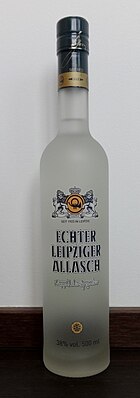Kümmel (liqueur)

Kümmel, kummel or kimmel (Latvian: ķimelis), is a sweet, colourless liqueur flavoured with caraway (German: Kümmel, Latvian: ķimenes) seeds, cumin and fennel.
Kummel was first distilled in the Netherlands in the late 17th century. in It was then taken to Germany, now the principal producer and market, and to Russia.
History
[edit]Origin
[edit]Historians state that Lucas Bols (1652-1719) first distilled kümmel liqueur in the Netherlands in 1675.[1][better source needed]
19th century
[edit]Kümmel's popularity grew in the early 19th century.[2] being produced by 1823[3]
Allasch is a variety of Kümmel; it is also a caraway liqueur of around 40% ABV, usually flavoured with bitter almonds, anise, angelica root and orange peel. Invented in 1823 in Allasch, Governorate of Livonia, Russian Empire (now Allažmuiža [lv] in Latvia), and produced by Wilhelm von Blanckenhagen (1761–1840), who owned land around Allasch which included a pure and reliable water source,[4] it was widely popular and produced there until 1944 when the Soviet Union re-occupied Latvia and expelled ethnic Germans from the region.
In 1830, Allasch was exhibited at the Leipzig Trade Fair and quickly gained popularity, being soon produced by local distilleries. It is now considered a Leipzig specialty, usually drunk as a digestif, although there are also manufacturers outside Leipzig.[5]
Albert Wolfschmidt founded a distillery in Riga in 1847, producing vodka and schnapps, including kümmel and Riga Black Balsam.[3]
In the mid-19th Century, kümmel was the rival of gin. Being made with caraway rather than juniper, it had the advantage that caraway has a calmative effect, reducing flatulence and the bloated feeling experienced after a heavy meal. By 1850,[3] this "medicinal" benefit helped Ludwig Mentzendorff create a healthy business importing kümmel to Britain.
20th century
[edit]During the 1905 Russian Revolution,[2] the Blanckenhagen mansion was burned down. The distillery closed, and the entrepreneurial Mentzendorffs opened up the production of their own kümmel in France. Baltic Germans moved to Germany as tensions between Russia and Germany grew, and several distilleries in Germany produced their own versions of kümmel, where it is still known as Allasch and is a popular digestif.

In Latvia, it is produced by Latvijas Balzams under the Latvianized name "Allažu ķimelis".[6]
In Scotland, it is a popular drink at many of the more traditional golf clubs[7] because of its rumored ability to steady the nerves of golfers there, acquiring the nickname of "putting mixture".[2]
A charming and evocative scene of drinking kümmel occurs in Rainer Werner Fassbinder's television miniseries, "Berlin Alexanderplatz" (1980), where the character Franz Biberkopf speaks in the voices of glasses of kümmel and three beers in a philosophical dialogue as he evaluates the taste and downs each drink in turn.
References
[edit]- ^
Calabrese, Salvatore (2002). Complete Home Bartender's Guide. Sterling Publishing. p. 192. ISBN 0-8069-8511-9.
According to historians, the first liqueur was a preparation made from caraway (called kummel), and distilled in 1575 by Lucas Bols in Holland. Bols knew that caraway was good for the digestive system, and he hoped that it would be popular when combined with the anesthetic effect of alcohol.
- ^ a b c "allasch - The Curiologist".
- ^ a b c "The Historians - Lost Ingredients: Kümmel".
- ^ "Spezialitaten". Leipzig-dasdorf.de. Retrieved 2017-01-19.
- ^ "Allasch | Preussische Spirituosen Manufaktur". Psmberlin.de. Archived from the original on 2016-12-01. Retrieved 2017-01-19.
- ^ "Allažu ķimelis". Latvijas Balzams. Retrieved 2018-04-07.
- ^ Lyons, Will (11 July 2013). "Kümmel: A Little of the Muirfield Spirit". Wall Street Journal.
